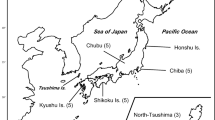Abstract
The radiation of canaries (genus Serinus) occurred in Africa and Eurasia during the Miocene Epoch (9 million years ago) according to maximum parsimony (MP), neighbor-joining (NJ), maximum likelihood (ML) and Bayesian methodologies. Serinus canaria (wild canary) and S. serinus (European serin) together form one of the several polytomies within the genus Serinus phylogenetic trees. In a relatively late period, a wild ancestor of S. canaria invaded the Canary Islands, and these birds are the origin of all existing cage canaries, including the first genetically engineered animal: the red canary. The present analysis of the major histocompatibility complex (MHC) molecules in the Canary Islands' species S. canaria shows that the evolution of the MHC in this species is overall different and faster than that of continental species – namely, S. thibetanus (Asia) and S. mozambicus (Africa) – but particularly so in the peptide binding region. These data support the hypothesis that oceanic islands may be evolutionary reservoirs and not evolutionary dead ends.



Similar content being viewed by others
References
Arnaiz-Villena A, Timon M, Corell A, Perez-Aciego P, Martin-Villa JM, Regueiro JR (1992) Brief report: primary immunodeficiency caused by mutations in the gene encoding the CD3-gamma subunit of the T-lymphocyte receptor. N Engl J Med 327:529–533
Arnaiz-Villena A, Alvarez-Tejado M, Ruiz-del-Valle V, Garcia-de-la-Torre C, Varela P, Recio MJ, Ferre S, Martinez-Laso J (1998) Phylogeny and rapid northern and southern hemisphere speciation of goldfinches during the Miocene and Pliocene epochs. Cell Mol Life Sci 54:1031–1041
Arnaiz-Villena A, Alvarez-Tejado M, Ruiz-del-Valle V, Garcia-de-la-Torre C, Varela P, Recio MJ, Ferre S, Martinez-Laso J (1999) Rapid radiation of canaries (Genus Serinus). Mol Biol Evol 16:2–11
Birkhead T (2004) The Red Canary: the story of the first genetically engineered animal. Orion Public Company, London
Bjorkman PJ, Saper MA, Samraoui B, Bennett WS, Strominger JL, Wiley DC (1987) Structure of the human class I histocompatibility antigen, HLA-A2. Nature 329:506–512
Bonneaud C, Sorci G, Morin V, Westerdahl H, Zoorob R, Wittzell H (2004) Diversity of Mhc class I and IIB genes in house sparrows (Passer domesticus). Immunogenetics 55:855–865
Dietzen C, Voigt C, Wink M, Gahr M, Leitner S (2006) Phylogeography of island canary (Serinus canaria) populations. J Ornithol 147:485–494
Filardi CE, Moyle RG (2005) Single origin of a pan-Pacific bird group and upstream colonization of Australasia. Nature 438:216–219
Huelsenbeck JP, Ronquist F (2001) MRBAYES: Bayesian inference of phylogeny. Bioinformatics 17:754–755
Hughes AL, Nei M (1988) Pattern of nucleotide substitution at major histocompatibility complex class I loci reveals overdominant selection. Nature 335:167–170
Klein J (1986) Natural history of the major histocompatibility complex. Willey, New York
Klein J, Bontrop RE, Dawkins RL, Erlich HA, Gyllensten UB, Heise ER, Jones PP, Parham P, Wakeland EK, Watkins DI (1990) Nomenclature for the major histocompatibility complexes of different species: a proposal. Immunogenetics 31:217–219
Kumar S, Tamura K, Ingrid B, Nei M (2001) MEGA2: Molecular Evolutionary Genetics Analysis software, version 2.0. Arizona State University, Tempe
Parham P, Lomen CE, Lawlor DA, Ways JP, Holmes N, Coppin HL, Salter RD, Wan AM, Ennis PD (1988a) Nature of polymorphism in HLA-A, -B, and -C molecules. Proc Natl Acad Sci USA 85:4005–4009
Parham P, Lomen CE, Lawlor DA, Ways JP, Holmes N, Coppin HL, Salter RD, Wan AM, Ennis PD (1988b) Nature of polymorphism in HLA-A, -B, and -C molecules. Proc Natl Acad Sci USA 85:4005–4009
Pasquet E, Thibault JC (1997) Genetic differences among mainland and insular forms of the Citril Finch Serinus citrinella. Ibis 139:679–684
Richardson DS, Westerdahl H (2003) MHC diversity in two Acrocephalus species: the outbred Great reed warbler and the inbred Seychelles warbler. Mol Ecol 12:3523–3529
Ronquist F, Huelsenbeck JP (2003) MRBAYES 3: Bayesian phylogenetic inference under mixed models. Bioinformatics 19:1572–1574
Sambrook J, Fritsch EF, Maniatis T (1989) Molecular cloning: a laboratory manual. Cold Spring Harbor Laboratory Press, New York
Sato A, Mayer WE, Tichy H, Grant PR, Grant BR, Klein J (2001) Evolution of Mhc class II B genes in Darwin’s finches and their closest relatives: birth of a new gene. Immunogenetics 53:792–801
Schwede T, Kopp J, Guex N, Peitsch MC (2003) SWISS-MODEL: An automated protein homology-modeling server. Nucleic Acids Res 31:3381–3385
Swofford DL (2002) PAUP*. Phylogenetic analysis Using parsimony (* and other methods) version 4. Sinauer Assoc, Sunderland
Westerdahl H, Wittzell H, von Schantz T (1999) Polymorphism and transcription of Mhc class I genes in a passerine bird, the great reed warbler. Immunogenetics 49:158–170
Zamora J, Lowy E, Ruiz-del-Valle V, Moscoso J, Serrano-Vela JI, Rivero-de-Aguilar J, Arnaiz-Villena A (2006a) Rhodopechys obsoleta (desert finch): a pale ancestor of greenfinches (Carduelis spp.) according to molecular phylogeny. J Ornithol 147:448–456
Zamora J, Moscoso J, Ruiz-del-Valle V, Lowy E, Serrano-Vela JI, Ira-Cachafeiro J, Arnaiz-Villena A (2006b) Conjoint mitochondrial phylogenetic trees for canaries (Serinus spp.) and goldfinches (Carduelis spp.) show several specific polytomies. Ardeola 53:1–17
Acknowledgements
This work was supported in part by grants from the Spanish Ministerio de Educación y Ciencia (PM-1999–023 and BMC-2001–1299) and Fundación Mutua Madrileña Automovilista. We thank Prof. Michael Wink and Javier Gonzalez for their help on handling Bayesian analyses.
Author information
Authors and Affiliations
Corresponding author
Additional information
Communicated by M. Wink.
Rights and permissions
About this article
Cite this article
Arnaiz-Villena, A., Lowy, E., Ruiz-del-Valle, V. et al. Evolution of the major histocompatibility complex class I genes in Serinus canaria from the Canary Islands is different from that of Asian and African continental Serinus species. J Ornithol 148 (Suppl 2), 479–484 (2007). https://doi.org/10.1007/s10336-007-0146-0
Received:
Revised:
Accepted:
Published:
Issue Date:
DOI: https://doi.org/10.1007/s10336-007-0146-0




